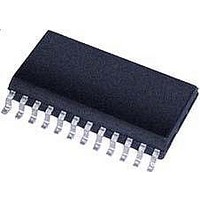CS5460A-BSZR Cirrus Logic Inc, CS5460A-BSZR Datasheet - Page 33

CS5460A-BSZR
Manufacturer Part Number
CS5460A-BSZR
Description
IC Sngl-Phs Bi-Directional Power/Energy
Manufacturer
Cirrus Logic Inc
Datasheet
1.CS5460A-BSZ.pdf
(54 pages)
Specifications of CS5460A-BSZR
Input Impedance
30 KOhm
Measurement Error
0.1%
Voltage - I/o High
0.8V
Voltage - I/o Low
0.2V
Current - Supply
2.9mA
Voltage - Supply
4.75 V ~ 5.25 V
Operating Temperature
-40°C ~ 85°C
Mounting Type
Surface Mount
Package / Case
24-SSOP
Meter Type
Single Phase
Lead Free Status / RoHS Status
Lead free / RoHS Compliant
For Use With
CDB5460AU - EVALUATION BOARD FOR CS5460A
Lead Free Status / Rohs Status
Lead free / RoHS Compliant
Available stocks
Company
Part Number
Manufacturer
Quantity
Price
Company:
Part Number:
CS5460A-BSZR
Manufacturer:
CIRRUS
Quantity:
8 000
Part Number:
CS5460A-BSZR
Manufacturer:
CIRRUS
Quantity:
20 000
The
surge-current limits of 100 mA. This applies to brief
voltage/current spikes (<250 ms). The limit is
10 mA for DC input overload situations. To prevent
permanent damage to the CS5460A, the designer
must include adequate protection circuitry in the
power meter design, to insure that these pin cur-
rent limits are never exceeded, when CS5460A is
operating in the intended power-line metering envi-
ronment.
Focusing specifically on Figure 7, which shows
how voltage/current transformers can be used to
sense the line-voltage/line-current, suppose for ex-
ample that the requirements for a certain 120 VAC
power system require that the power meter must
be able to withstand up to a 8 kV voltage spike on
the power line during normal operating conditions.
To provide a suitable sensor voltage input level to
the voltage channel input pins of the CS5460A, the
turns ratio of the voltage-sense transformer should
be chosen such that the ratio is, for example, on
the order of 1000:1. A voltage-sense transformer
with a 1000:1 turns ratio will provide a 120 mV
(rms) signal to the CS5460A’s differential voltage
channel inputs, when the power line voltage is at
the nominal level of 120 VAC. Therefore, a brief
8 kV surge would be reduced to a 8 V surge across
R
What happens when 8 volts (common-mode) is
present across one of the analog input pins of the
CS5460A? The Vin+/Vin- and Iin+/Iin- pins of the
CS5460A are equipped with internal protection di-
odes. If a voltage is presented to any of these pins
that is larger than approximately 7 V (with respect
to VA- pin) these protection diodes will turn on in-
side the CS5460A. But in order to prevent exces-
sive current levels from flowing through the device,
the value of R
8V surge is present across the secondaries of the
voltage-sense transformer, the brief surge current
through R
100 mA. Therefore, a minimum value for R
would be (8 V - 7 V) / 100 mA = 10 Ω. This value
may be increased as needed, to easily obtain the
desired cutoff frequency of the anti-aliasing filter on
the voltage channel (described later), and also to
provide some margin. But the designer should try
DS487F4
V+
.
voltage/current-channel
V+
V+
should not be any greater than
must be large enough that when a
inputs
have
V+
to avoid using values for the protection resistors
that are excessively high. A typical value for R
would be 470 Ω.
The VIN- pin should also have a protection resistor
(called R
value of R
For the current channel inputs (Iin+ and Iin-), if the
maximum current rating (I
30 A (RMS), then a suitable turns ratio for the cur-
rent-sense transformer might be 200:1. Since the
maximum load for a 120 VAC line rated at 30 A
would be 4 Ω (for unity power factor), a brief 8 kV
surge across “L” and “N” could generate as much
as 2000 A (RMS) of current through the primaries
of the current-sense transformer. This can in turn
generate as much as 10 V across the secondaries
of the current-sense transformer. This voltage is
high enough to turn on one or more of the internal
protection diodes located off of the Iin+/Iin- pins.
Therefore, the value of the protection resistor that
will limit the current flow to less than 100 mA would
be (10 V - 7 V) / 100 mA = 30 Ω. In order to pro-
vide some margin and to use the same resistor val-
ues that are used on the Vin+/Vin- pins, a 470 Ω
resistor can be used as a lower limit for the R
R
Referring to the circuit implementations shown in
Figures 6, 8, and 9, note that when resistor-divider
configurations are used to provide the voltage
channel sense voltage, the VIN+ pin does not need
an additional, separate, dedicated protection resis-
tor. This is because the resistive voltage-divider al-
ready provides the series resistance that is needed
for this protection resistance (from R
(And note in Figure 8 that this is true for both the
VIN+ pin and the VIN- pin.) In Figure 7, a voltage
transformer is used as the voltage sensor. When
any type of transformer is used as the sensor de-
vice for voltage (or current) channel, a dedicated
protection resistor R
with the VIN+ pin, and similarly, a resistor (R
should be installed in series to the VIN- input pin.
Additional considerations/techniques regarding
the protection of the analog input pins against sud-
den high-frequency, high-level voltage/current
surges are discussed in Section 3.14.
I-
resistors shown in Figure 7.
V-
V-
in Figure 7). To maintain symmetry, the
should be made equal to R
V+
should be installed in series
max
) for this power line is
CS5460A
1
V+
and R
.
I+
and
2
33
V-
V+
).
)


















